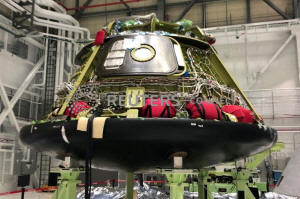|
Exclusive: SpaceX, Boeing design risks
threaten new delays for U.S. space program
 Send a link to a friend
Send a link to a friend
 [February 21, 2019]
By Eric M. Johnson [February 21, 2019]
By Eric M. Johnson
SEATTLE (Reuters) - NASA has warned SpaceX
and Boeing Co of design and safety concerns for their competing
astronaut launch systems, according to industry sources and a new
government report, threatening the U.S. bid to revive its human
spaceflight program later this year.
NASA is paying SpaceX $2.6 billion and Boeing $4.2 billion to build
rocket and capsule launch systems to return astronauts to the
International Space Station from U.S. soil for the first time since
America's Space Shuttle program went dark in 2011.
Just ahead of the first scheduled un-manned test flight slated for March
2 under NASA's multibillion-dollar Commercial Crew Program, NASA's
safety advisory panel cited four "key risk items" in its 2018 annual
report earlier this month.
For Boeing, they include the capsule's structural vulnerability when the
heat shield is deployed. For SpaceX, the report mentioned the redesign
of a SpaceX rocket canister following a 2016 explosion and its "load and
go" process of fueling the rocket with the crew already inside the
capsule. "Parachute performance" remained an issue for both companies.

"There are serious challenges to the current launch schedules for both
SpaceX and Boeing," the report said.
For an interactive version of this story, click https://tmsnrt.rs/2V6pXyN
Two people with direct knowledge of the program told Reuters that the
space agency's concerns go beyond the four items listed, and include a
risk ledger that as of early February contained 30 to 35 lingering
technical concerns each for SpaceX and Boeing. Reuters could not verify
what all of the nearly three dozen items are. But the sources familiar
with the matter said the companies must address "most" of those concerns
before flying astronauts and, eventually, tourists to space.
The NASA risk database is updated routinely during the course of NASA's
stringent certification process, which includes data collection, tests
and collaboration with SpaceX and Boeing, the people said. The Boeing
and SpaceX systems have already been delayed several times in recent
years, which is common in this sector given the complexity of building
multibillion-dollar spacecraft capable of shedding earth's gravity.
NASA spokesman Joshua Finch deferred all technical questions on Boeing
and SpaceX systems to the companies, citing confidentiality, but said:
"Flying safely always takes precedence over schedule."
Boeing spokesman Josh Barrett said the company "closed out" the
capsule's structural vulnerability risk when it completed its structural
test program in January. While Boeing is working through a number of
other issues, they "are not driving any major architectural system
changes."

"Our numbers show we are exceeding NASA's safety requirements," said
Barrett.
SpaceX spokesman James Gleeson said the company, working with NASA, has
developed "one of the safest, most-advanced human spaceflight systems
ever built."
"There is nothing more important to SpaceX than safely flying crew,"
said Gleeson, calling it "core to our company's long-term goal of
enabling access for people who dream of flying to space."
Founded by Tesla Inc Chief Executive Elon Musk, SpaceX has cut the cost
of rocket launches with its pioneering reusable rocket technology, while
Boeing traces its space business back to the first U.S. human space
missions of the 1960s and is also the world's largest planemaker.
The clock is ticking. The U.S. has been paying Russia about $80 million
per ticket for a ride to the International Space Station, a $100 billion
orbital research laboratory that flies about 250 miles (402 km) above
Earth.
There are no seats available for U.S. crew on the Russia spacecraft
after 2019 given production schedules and other factors. NASA said last
week it was considering paying for two more seats to the space station
for this fall and spring 2020 to ensure U.S. access.
The NASA plan for extra seats came a week after its safety panel said
Congress should come up with a "mitigation plan" in case delays threaten
U.S. access to the space station - echoing earlier concerns from the
U.S. Government Accountability Office.
[to top of second column]
|

One of Boeing Co's CST-100 Starliner astronaut capsules is seen at a
production facility in Cape Canaveral, Florida, U.S., January 15,
2019. REUTERS/Eric M. Johnson

NASA is set to conduct a flight readiness review on Friday for
SpaceX's mission without a crew on March 2. NASA will decide whether
to approve the test flight without a crew, while SpaceX addresses
the issues raised for a human mission.
PARACHUTE WEAKNESSES
Three people familiar with the project say the U.S. space agency has
identified some design discrepancies between earlier SpaceX capsules
designed to haul cargo to the International Space Station, and a
newer version designed to carry humans.
Some of the risks - such as those identified in the designs of the
enormous parachutes that deploy when the capsule plummets back to
Earth at supersonic speeds - are uncommon given how close SpaceX is
to test flights, two of the people said.
The timing of deployment of the SpaceX parachutes and the
interaction of the parachutes themselves have raised concerns about
parachute performance, and potentially whether they will be able to
slow down the capsule enough to ensure the crew's safety, two people
said.
SpaceX has completed 17 parachute tests for the Commercial Crew
Program so far, with an additional 10 tests planned prior to Crew
Dragon's second demonstration mission, Gleeson said. He also said
its parachute systems are designed with redundancy so the vehicle
can still safely splashdown in the event that one parachute fails.
NASA's safety panel said in its report that SpaceX may be required
to re-design its parachute system. A re-design would likely trigger
more testing and potentially weeks or months of extra delays, two of
the people said.

NASA also found design problems with the system that helps orient
SpaceX's capsule in an upright position once it lands in the ocean,
raising the risk of taking on excessive amounts of water, according
to two industry sources and confirmed by a NASA official.
SpaceX's Gleeson said Crew Dragon's outer shell is water-resistant,
and the spacecraft itself is buoyant and does not pose a risk to
crew members after splashdown.
RISK OF MORE DELAYS
NASA announced earlier this month that SpaceX was now targeting
March 2 instead of Feb. 23 for its un-crewed Crew Dragon test
flight, with its astronaut flight planned for July. NASA explained
the delay by citing vague concerns for both contractors, such as the
need to complete hardware testing and other work.
NASA said Boeing's un-crewed Starliner would fly "no earlier" than
April, with the crewed mission currently slated for August. This is
the schedule now at risk, according to the NASA report.
The challenges in front of Boeing include last year's failure during
a test of its launch-abort engines, which spilled caustic fuel on
the test stand, Boeing's Barrett said. The accident was caused by
faulty valves which Boeing has re-designed and re-ordered from the
supplier, though the new valves must be re-tested, Barrett said.
The test flights are also part of collecting the data needed to
close out some risk items, NASA said.
"SpaceX and Boeing both have challenges, both comparable, from a
safety perspective," said one U.S. government source.
(Reporting by Eric M. Johnson in Seattle; Additional reporting by
Tracy Rucinski in Washington and Joey Roulette in Orlando, Florida;
Editing by Edward Tobin)
[© 2019 Thomson Reuters. All rights
reserved.]
Copyright 2019 Reuters. All rights reserved. This material may not be published,
broadcast, rewritten or redistributed.
Thompson Reuters is solely responsible for this content.
 |